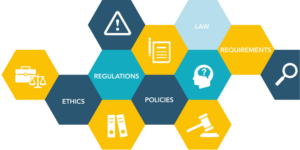If you’re not comfortable with new technology, you’re not alone. While certain brave souls among us, the innovators and early adopters, embrace cutting-edge new technologies with enthusiasm, the majority of us are somewhere in the middle of the Rogers adoption curve.
It’s true that there are plenty of legitimate reasons to fear new technology, but fortunately there are also ways to overcome those fears. For those who do learn to adopt new tools and adapt to a changing world, the benefits are tremendous — especially when it comes to ediscovery technology.
But first, how did we get here?
A Brief History of Change
For most of human history, “technology” has been limited and slow to develop. Fire was once a new tool that allowed humans to cook food. The wheel was once the height of innovation. From 1900 until the 1980s, technological change and adoption grew at a relatively leisurely pace.
Beginning in the 1980s, with the birth of personal computers, change began to accelerate. In the space of 10 years, we advanced from clunky, slow, monochromatic computer monitors to briefcase-style cell phones. Then came the internet. Computers got smaller, faster, and entirely better; phones got smaller for a time and then became larger as they grew shockingly more capable and complicated. Today, everything is in the nebulous cloud, and many younger people eschew computers altogether in favor of mobile devices and apps.
While it can be startling to consider the rapid pace of technological development over the last 30 years, most of the changes have tangibly improved our day-to-day lives. In 1985, we had the Clapper; today, your home can recognize your arrival and turn on your favorite lights for you before you walk in the door. VCRs boomed in the 1980s, revolutionizing television-watching (not long before then, television was called books). After just a few decades, VCRs are obsolete — you can literally tell your TV what you want to watch, and it will take care of the rest. Along the way, the ability to adapt to constant change with flexibility and agility became a survival skill.
Yet fears about technology — especially when it comes to ediscovery — are generally based on reasonable, valid business concerns. Let’s consider five common fears about ediscovery technology and offer a few ways to overcome each one.
A recent study by Bloomberg Law and Catalyst found that 72% of corporate counsel still lack a unified strategy for adopting technology, instead buying individual products as they’re needed.
Fears — and How to Address Them
1. Fear of change
Familiarity tends to breed comfort, not contempt, when it comes to processes and systems. Therefore, staff are often reluctant to embrace new technology after they have become accustomed over time to using traditional methods and procedures. That’s especially true when your current systems are dated and manual, requiring a sea change in processes and infrastructure.
The risk of upsetting the apple cart, with all of its attendant stressors, such as the need for employees to spend time learning the system rather than doing value-added work, can discourage the adoption of new technology.
A recent study by Bloomberg Law and Catalyst found that 72% of corporate counsel still lack a unified strategy for adopting technology, instead buying individual products as they’re needed. And far too many still rely on their old manual standby that they’ve used to track legal holds for decades now: emails and spreadsheets.
SOLUTION: As Ben Franklin said, “When you’re finished changing, you’re finished.” Nowhere is this more true than for businesses today. Yes, it’s hard to reimagine the way you do business, especially when you’re busy just keeping up, but the alternative is stagnation. Invest proactively in a wraparound technology strategy rather than waiting for trouble and reacting to it. Start by learning about the benefits of new cloud-based legal technology solutions, perhaps beginning with data preservation, a discrete and straightforward stage. (Besides, don’t automated legal hold notices sound so much easier than sending countless emails?) Finally, remember that you likely don’t have a choice; your ethical duties require you to keep up with technology.
RESOURCE:When Change Is the Only Constant, You Can Thrive, Adapt or Die Off: Embrace Change in Ediscovery
2. Intimidation
The idea of having to implement technology in a large organization can seem like a monumental task, especially if that technology requires extensive deviations from old processes or software solutions. In this case, the sheer scale of the task is the impediment.
Former bookseller Borders is a clear example of the failure to update systems — in that case, the failure to compete online. The company outsourced its web services to Amazon from 2001 until 2008, when it finally created its own website. Meanwhile, it invested in its well-worn retail footprint, signing long-term leases in subpar locations that saddled it with debt. As Borders continued with its same-old approach, dropping sales compounded the expensive lease arrangements and led the company to file for bankruptcy. Its failure to tackle the problem of the internet spelled its downfall. Don’t follow suit.
SOLUTION: Don’t try to eat the entire elephant at once; break it down into manageable bites. These small steps can stack into something big. Map out the process in advance, dividing it into more manageable tasks that satisfy the SMART goal framework. Recruit support and assign someone — or even a team of people — to shepherd your organization through the transition.
RESOURCE: The Ultimate Ediscovery Guide: A Six-Step Approach to Moving Ediscovery in House
Deciding to stick with what you’ve got isn’t really a viable choice: you’re likely to be left in the dust and then you’ll have to make a choice or suffer even more dire consequences.
3. Fear of making the wrong choice
With so many options, and those options changing so quickly, it can be challenging to choose between solutions. Fear of making the wrong choice is especially troublesome because choosing the wrong solution can lead to considerable problems.
For example, you might choose a technology that is quickly outdated. You might choose the ediscovery version of Betamax while everyone else goes with VHS — creating an utter disaster that can only be fixed by spending another sum on different technology. You might, like RIM, refuse to adopt a touchscreen, opting instead to continue including a physical keyboard on your phones. That fear led the once ubiquitous BlackBerry to be rapidly eclipsed by the iPhone.
As these examples show, deciding to stick with what you’ve got isn’t really a viable choice: you’re likely to be left in the dust and then you’ll have to make a choice or suffer even more dire consequences.
SOLUTION: Read about the risks of obsolescence. Look at what your competition is doing. Check out where your competitors from 10 years ago are today; did they leave you in the dust while you stagnated? Then, do your research before selecting a solution. Talk with people who have upgraded their technology and find out how it’s working. Ask what they would do differently next time. Take advantage of research tools like Capterra and G2 Crowd to assess the variety of options on the market.
RESOURCE: Seven Steps to Choosing Litigation Response Software
4. Fear of financial missteps
With discovery accounting for up to 50 percent of litigation costs in federal court, it’s important to make the right choice when allocating your financial resources. The questions boil down to these: how much ediscovery should you outsource, and what technology do you need to handle what you keep in house?
With so many options for pricing, from flat rates per amount of data or the number of users vs. a usage pricing model, the decision can be daunting, particularly if you’re making it in a vacuum. And rarely are the charges from ediscovery vendors transparent, making it nearly impossible to compare apples to apples. Not to mention that you’re probably also worried, above and beyond the typical charges for collection, processing, and hosting, about the unpredictable charges that might be lurking around the corner, such as rush fees, project management costs, and customer support charges.
SOLUTION: Learn about the benefits of updating your technology and the costs of avoiding technology. Study the total cost of ownership (TCO) and return on investment (ROI) for any software you consider. Learn about both the benefits of new technology and the full costs of not upgrading. Chances are, you can’t afford to do nothing; not making a choice is not a viable growth strategy. Moreover, if your budget is already stretched to the max, today’s cloud-based ediscovery software is affordable and right-sized, with volume-based pricing.
RESOURCE: Calculate the ROI of Ediscovery Software
Employees may feel defeated, fearing that they’ll lose their jobs to technology.
5. Fear of staffing changes
Use of new technology may mean that certain employees no longer have a function, much less a role, in the “new and improved” technologically upgraded legal department. With all the talk of machines armed with artificial intelligence replacing human workers, employees may feel defeated, fearing that they’ll lose their jobs to technology and giving up without even trying to adapt. Employees may also wonder where they fit with the rise of new ediscovery roles needed to handle complex cybersecurity and privacy issues, such as the Data Protection Officer (DPO) role necessitated by the EU’s General Data Protection Regulation (GDPR).
SOLUTION: Frame the adoption of technology as a way to improve jobs, making them more efficient and less burdensome, not as a way to reduce costs by eliminating headcount or replacing senior employees. The Bureau of Labor Statistics predicts that the job market for paralegals and legal support technicians will improve by a whopping 15% between 2016 and 2026. Show people how new technology won’t steal their jobs but will instead streamline their responsibilities, allowing them to focus on more value-added tasks. Schedule a weeklong in-office “retreat” to onboard everyone and arrange specialized training where appropriate to retain less technologically prepared employees. Consider recruiting new hires for specific tech-focused roles, such as project managers or systems engineers who can fill competency gaps in the current legal and IT teams, and integrating those roles with existing employee structures. Reuters reports that as many as 75,000 DPOs will be needed worldwide for companies to comply with the GDPR; while roles may change, the opportunities for legal support staff to advance their careers have never been greater.
RESOURCE: In Ediscovery, If You’re Not Getting Ahead, You’re Falling Behind
How These Fears Manifest
Individuals or entire companies that give in to these fears generally fall into a few typical patterns. They may:
- Not adopt any technology at all for at least one specific job or process. This is common with legal holds; many businesses continue to rely on slow manual processes, using email and spreadsheets to issue legal holds and monitor compliance.
- Dismiss technology out of hand or never consciously consider it. Most often this blind spot occurs when people or organizations are afraid of overwhelm, disruption, or failure. This is also a characteristic of inertia. Often these businesses struggle with other large projects or lag in adapting to other areas of change.
- Wait for a clear consensus market leader before choosing a technological solution. This delay arises from a fear of choosing the wrong option or a fear of obsolescence. Unfortunately, while a business is waiting for the market to select a clear “best” choice, its competitors are getting ahead with whatever technological solutions they’ve chosen. And there’s no guarantee that the market will ever settle on a consensus winner — or that it would be the best option for a particular business.
Companies that put off adopting technology or reject it because they fear obsolescence themselves become obsolete.
The Results of Fearing Technology
Businesses that don’t adopt new technologies, regardless of the reason, may avoid the fear they’ve zeroed in on, but they’ll face other problems. Often, the cost of not using new technology is worse than the risk or the fear that’s inhibiting action.
For example, companies that put off adopting technology or reject it because they fear obsolescence themselves become obsolete. Whatever technology they do use — whether that’s typewriters or Microsoft® Word 95 — won’t be supported forever. Finding supplies, getting repairs, contacting customer support, and working through compatibility issues can all waste time, and they’re only going to get worse as those products get older.
Don’t let yourself, or your business, become a dinosaur. You can become not merely archaic but a business liability if you fall entirely out of touch with current technology. At the current pace of change, catching up becomes exponentially more difficult as time passes. Closely associated with the risk of becoming a relic is the reality that adaptation and flexibility are skills — and those individuals and businesses that don’t practice them never get good at them.
Benefits of Adopting New Technology
On the other hand, those businesses that overcome their fears and adopt new ediscovery technologies reap a host of benefits. First and foremost, they save money and time on their ediscovery processes via strong early case assessment, targeted collection, automated in-place preservation, cloud hosting and storage, and limited processing and review. They’re strong competitors, thriving in the modern world of business. They’re acclimated to change, and they adapt quickly to whatever crosses their path. They’re pioneers and industry leaders.
And you could be among them.




